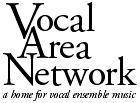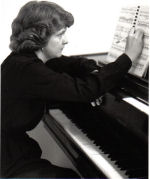 |
 |
Advertise | Sustaining Membership | VAN Store | Feedback
by Kimberly Hiss for Vocal Area Network
Posted March 12, 2006
 On
March 26 and April 2, the Russian Chamber Chorus of New York will perform its
spring 2006 program, which will include the works of Tchaikovsky, Shostakovich,
and the premier of a new choral cycle by an American composer. The following
interviews with the group's artistic director and conductor Nikolai Kachanov and
the new work's composer Sarah Dawson offer a preview of the concert.
On
March 26 and April 2, the Russian Chamber Chorus of New York will perform its
spring 2006 program, which will include the works of Tchaikovsky, Shostakovich,
and the premier of a new choral cycle by an American composer. The following
interviews with the group's artistic director and conductor Nikolai Kachanov and
the new work's composer Sarah Dawson offer a preview of the concert.
PART ONE: The Artistic Director
In the early 1980s, Nikolai Kachanov sat up nights in his tiny Astoria kitchen planning concerts for a chorus that didn't exist yet. He and his wife Tamara and their son Pavel had recently emigrated from the Soviet Union, where his successful career as a choral conductor had been limited by bans on Russian liturgical music. Kachanov set out to rebuild in New York, where he started work in a piano factory, learned English, and sat up nights imagining the concerts he'd give again someday.
Today the Kachanovs are in the midst of their 21st season with the Russian Chamber Chorus of New York--and the program for their upcoming spring concert is far from imaginary. It's a collection of music that only Kachanov could conceive and only the Russian Chamber Chorus could perform--a perfect reflection of the Maestro's personal journey from Russia to the States, and his resulting philosophy about the two musical cultures. Kachanov took some time from preparing for the concert to answer a few questions.
VAN: I'm sure some people will wonder why the RCCNY is performing and
even commissioning American music.
NK: The idea of combining Russian and American already exists in our
title: Russian Chamber Chorus of New York. This title expresses our primary goal
of building a cultural bridge between the two countries. In the beginning we
performed only Russian choral music because it was unknown in America at that
time. And little by little, we began to perform American music. With Russia,
there's an unforgettable sense of the homeland. But in New York, I found my
second home and I have grown both personally and musically. And for me, the
ability to help an American composer to bring a piece of beauty into the world
colors my life.
VAN: How is that philosophy reflected in the spring concert program?
NK: We'll perform two very different pieces by Tchaikovsky: Let My
Prayer Arise and Nature and Love. One is sacred music, the other is
very much secular. People love Tchaikovsky because he opens to his listener the
very depths of a kind and loving heart, and so I paralleled his music with the Chant
by Yuri Yukechev, which I linked to Samuel Barber's Adagio for Strings.
The connection between these three composers lays in their deep dramatic
expression; it feels that these compositions come directly from the human heart.
VAN: Now, this is your own adaptation of the Adagio for Strings?
NK: About 17 years ago, I was talking with Edgar Lansbury, who is
Chairman of our organization, the Russian Musical Arts Society of America. He
gave me Barber's score for orchestra and said it might make a beautiful choral
piece. I did not know this score at that time, but I brought it home, and
practically overnight this adaptation for middle-sized choir was ready. I mixed
voices--sometimes tenors and altos in unison, sometimes tenors and baritones.
And I believe I found a way to keep the piece close to the original.
VAN: The second half of the program begins with the commissioned
piece?
NK: Yes, the beautiful Possibility by Sarah Dawson. It is eight
movements, most of them set to the poems of Emily Dickinson. I feel that her
poems are very musical, although I cannot say that I always understand them. But
Sarah's music has done a great deal to deepen my understanding. I believe she
was lucky to give life to this piece: it's colorful, sparkled with subtle and
exquisite humor, and very feminine. We've worked a great deal on the appropriate
pronunciation which is especially important for this piece, and we're developing
a style I call "New England vocal production" for this piece. It is a
simple, straight-forward, "pure" tone that is very much a contrast to
the rich, vibrato tones of the Russian style we are used to. We conclude the
concert with Antiformalist Rayok by Shostakovich. It's a crossing because
there's a contrast between Sarah's beautiful, watercolor style, and then
Shostakovich's extremely sharp, satirical expression, with the bass solo.
VAN: What do you hope the audience will get out of the concert?
NK: I believe it's a great program because it is different. When you
perform the same patterns like Liturgy by Tchaikovsky or Vespers
by Rachmaninoff, it is guaranteed that it will attract people. You know what to
expect, and of course it will be a success. But I think this is not enough for
either a musician or an audience. I love to discover new music. Our programs
very often have an educational element as we continue to introduce choral music
from Russia and the former Soviet republics. Sometimes I experiment with new
elements to see how the audience reacts. In this case, success very much depends
on collaboration with the audience, which will hopefully include some people who
are open to accepting new and different things.
VAN: What do you hope the singers will get out of learning such a
diverse repertoire?
NK: I'll start with myself. As a musician, I usually love every piece I
perform. To love the music means you dissolve yourself into it. And when you mix
your fibers with the music, it becomes a part of you. And for a moment, the
choir and I are absorbed by the beauty of the music, and no one remembers who he
or she is. We are absolutely equally dedicated and we become the same organism -
we breathe with the same phrasing and we think with the same images. And of
course it is a miracle, and of course in that moment we become closer than any
relatives. And the experience is best when the audience wants to be part of it
as well.
Again, I don't like patterns--I don't want to spend my life singing a seasoned staple like Messiah every year. Of course, we will always perform Russian liturgical and secular music, but when you sing different styles and genres, you expand your knowledge, develop your mind and heart, and improve your skill. In this program for example, the singers have to be able to switch their minds from Sarah Dawson's music, and transform themselves into furious followers of the Communist Party to create a satirical image of those monsters when they sing Shostakovich's one-act opera.
And that's part of a bigger subject. I feel uncomfortable thinking about the world as "them" and "me." I think mostly it's "us." From our best progressive striving to our most destructive, terrible action, it is "us." And that's why a program like this attracts me, because through the variety you experience yourself in a much richer way-not just the narrow, personal, blueprint pattern that you're used to. And of course, the singers will learn a lot of important things as musicians, and hopefully as human beings too.
PART TWO: The Composer
A few months ago, composer Sarah Dawson got a very welcome voice mail. She had recently sent her commissioned choral work Possibility to Kachanov. It was eight movements, six set to the poems of Emily Dickinson, two set to the poems of e.e. cummings and W.B. Yeats. And she had no idea how the work had been received until she came home to a new phone message. "Nikolai told me on the message how much he loved the piece--it was such a relief! Until that moment I wasn't terribly sure that the whole thing would come off. He said the piece would be a real challenge, but he didn't mind that."
Dawson had been a soprano with the Russian Chamber Chorus for a few years in the early 2000s. Once Kachanov became aware of her work as a composer, he came to deeply appreciate her talent and style. While Possibility was in rehearsals for its premier at the Russian Chamber Chorus' spring concert, Dawson answered a few questions about the piece's creation.
VAN: How did your composition process for this start?
SD: I'd gotten a small group of singers out of the Russian Chamber Chorus
to do another piece of mine called The Amber Quantity. We were having our
last rehearsals before the performance, and I was feeling kind of low because it
was all going to come to an end. The singers started saying, "Oh you have
to write us some more music because we don't want to stop singing your
music." I was so inspired that I went home that evening and wrote six of
the eight movements in one sitting--they just kind of dropped out of the sky.
VAN: How did you choose these particular poems?
SD: Before that night, I'd already set aside some pieces that I was
interested in. As I'd read through some poems, I could kind of feel whether I
could write music to them or not, and that's how I decided whether I was
interested or not. In a sense, these particular poems sang to me, so I fleshed
out the song. And I'm definitely trying to illuminate the text as I'm
writing--I'm sort of word painting or something.
VAN: What do you think the singers will get out of the piece?
SD: I'm hoping that the almost meditative process of repeating the text
and learning those wonderful poems will give the singers some kind of joy.
VAN: And the audience?
SD: I worry about the audience, actually, because it's hard to catch
everything in one hearing. Sometimes I think as an audience member trying to
hear a new piece, it's kind of hard to keep up with both the music and the
poetry at once.
VAN: Who are your musical influences?
SD: I've been especially influenced by Brahms, Copland, Berg and Barber:
Brahms for the long legato line, Copland for rhythm and harmony, Berg for
polyphony, and Barber for dramatic impulse.
VAN: What about the choir did you take into consideration when you
wrote the piece?
SD: Having sung with the choir for a number of years, I had their sound
well in mind. Actually, another small group of singers from the choir took the
time to sing through this piece as I was finishing it, and helped me to realize
if certain sections needed to be adjusted for certain voice parts. I'm very
grateful for that help. But in terms of the group as a whole, their capacity for
gorgeous legato and vibrant intonation is wonderful. Also, my thorough
admiration for Nikolai's interpretations gave me great freedom in what I could
put into the pieces, knowing that they would be lovingly brought to life.
You can hear Dawson's piece brought to life for the first time in performance at one of the Russian Chamber Chorus' two upcoming Manhattan concerts. The first is March 26 at 4:00 PM at New York University's Holy Trinity Chapel. The second is Sunday, April 2 at 7:30 PM at the Church of the Blessed Sacrament. For directions and ticket information, go to www.rccny.org.
Kimberly Hiss sings with the Russian Chamber Chorus of New York.